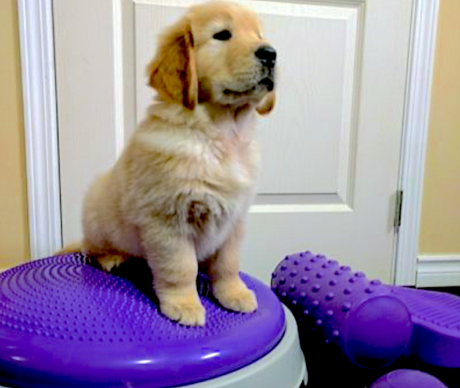
When talking to a friend recently, I made the comment that my average client has minimal training experience, so in many cases I need to rely on simple exercises with specialized equipment instead of specialized exercises with simple equipment to get the results I want. This caused me to think about the role that equipment plays in conditioning, especially considering how expensive it is.
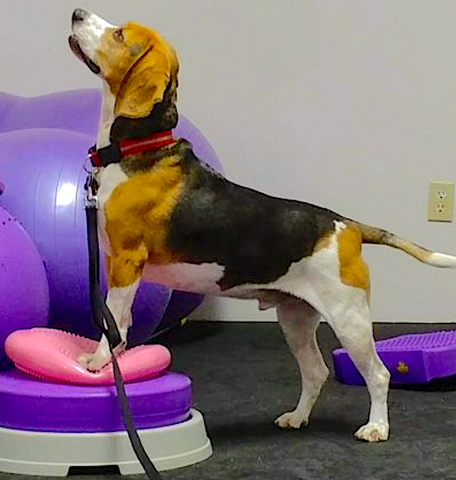
How Important is Canine Conditioning Equipment?
In my opinion, it’s important enough that I would consider it to be the fourth team member in the room, with the others being myself, my two-legged client, and my four legged client. The proper equipment gives me a toolbox I can choose from so that I can get the results I want for ALL of the dogs I work with, not just the ones who belong to experienced trainers. Every piece of equipment fulfills a specific purpose – if I don’t use it, I get rid of it. The equipment that I have multiples of are the pieces that I use the most and lend out the most.
The goal of this post isn’t to encourage you to go out and buy equipment; but instead to be thoughtful about how you are using the equipment you have. While in this post I refer to brand name equipment, below are a few charts that give inexpensive options for the conditioning equipment I use the most often. I will also add that my general philosophy is “anything is better than nothing” – so if you can’t find an unstable surface that is the perfect width, go ahead and use the wider surface – your dog will still benefit greatly and is lucky to have an owner who wants to do conditioning.
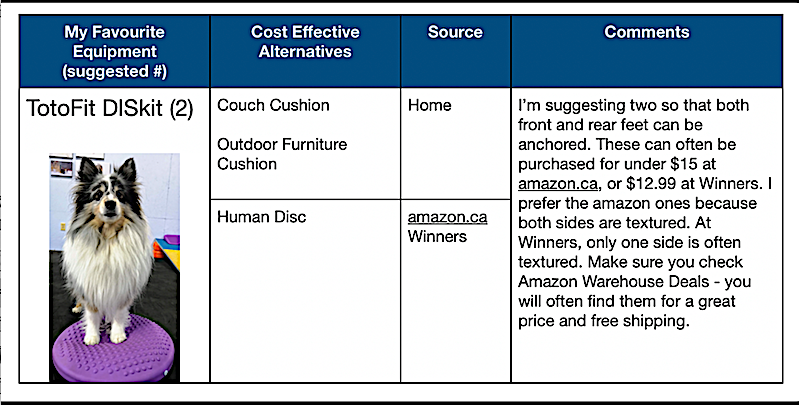
Balance Disc Textured Both sides (US Amazon Customers)
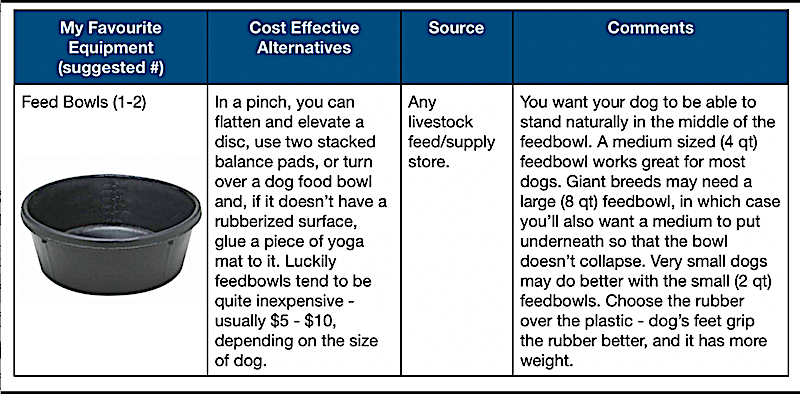
(US Amazon Customers)
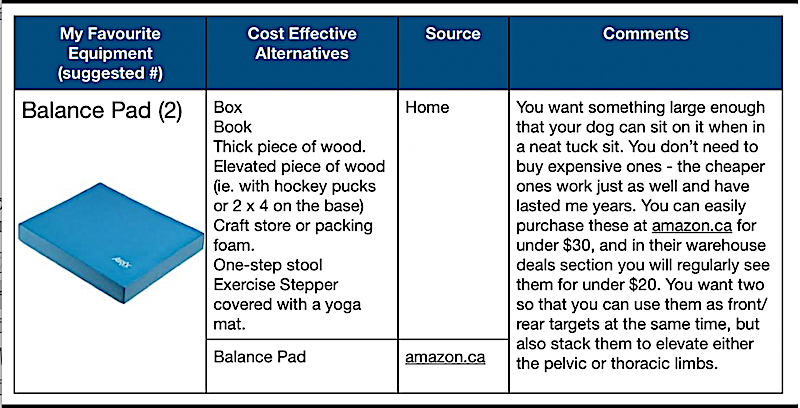
(US Amazon Customers)
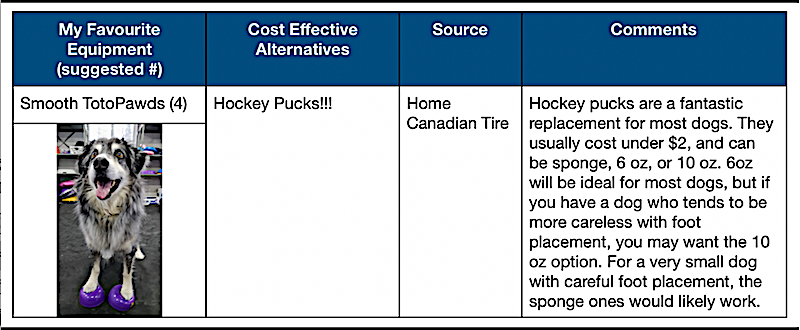
(US Amazon Customers)
Mini Foam Hockey Pucks (2″ diameter)
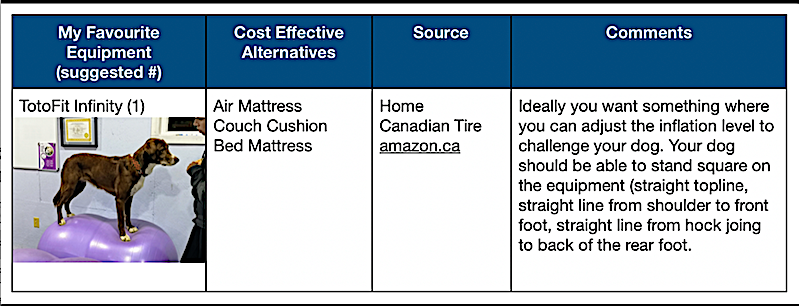
(US Amazon Customers)
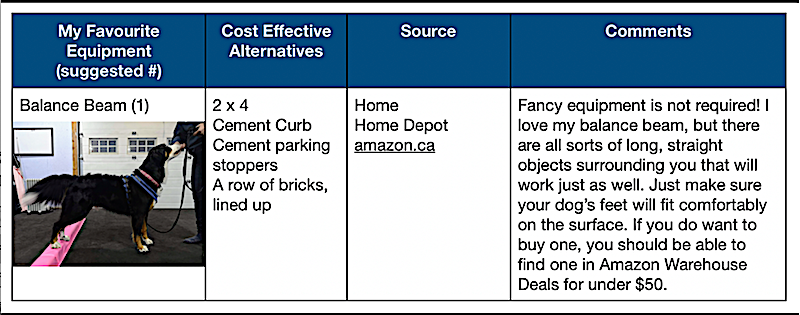
(US Amazon Customers)
Balance Beam
Stable vs. Unstable Surfaces
The exercises I choose to do and the equipment I incorporate depend on several factors.
- If I am looking to increase power or strength, I tend to work on a stable surface.
- If I am focusing on placing healthy stress on a specific joint, increasing muscle activation in the trunk or limbs, or balance and coordination challenges, I gravitate towards an unstable surface.
These differences are based on data extrapolated from studies on humans, but I’d also like to point out that due to the structure of the quadrupeds, another advantage I’ve noticed when using unstable equipment is that it tends to encourage dogs to engage limbs that are on solid ground. For example, if the front feet are targeting an unstable surface like an elevated TotoFit K9 Kore, I find that the rear assembly shows more muscle engagement than if they are targeting a solid surface like a pot. As with everything else you do, there should be balance. Power and force is important, but so is balance and joint stability.
Size Matters
- 3 sizes of FitBones
- 4 sizes of discs
- 2 sizes of wedges
- 3 sizes of feed bowls
Virtually every piece of equipment I have, I have in multiple sizes. Why? There’s a few reasons:
The smallest dog I work with is 3.5 lbs, the largest dog I work with is 220 lbs – so I have to have the appropriate size of equipment to meet the conditioning goals of these two dogs, as well as all the dogs in between these sizes.
When dogs start working on unstable surfaces, or are working on a new or challenging exercise, they tend to splay their limbs. This can also happen on stable surfaces, for example if they tend to stand cow hocked or if they have a “sloppy sit”. The size of the equipment surface, whether stable or unstable, provides a visual and physical cue to the dog that can be very useful in helping a dog learn to engage the muscles needed to stand, sit, or down with appropriate form and muscle engagement. I prefer using equipment without a ledge to it so that the dog has to engage their muscles to stay within the limits of the equipment, instead of bracing themselves on the equipment. As a dog advances, I’ll use larger equipment for various purposes as long as they continue to show proper form.
The size of the equipment can also impact a dog’s willingness to try new equipment. If I am working with a dog who is timid or unsure of the environment or equipment, I’ll bring out the large equipment so that I can build their confidence before worrying about form.
Structure = Safety and Predictability
When it comes to unstable surfaces, I want the challenge it creates to be consistent and predictable – which is why having structured unstable surfaces is so important. I don’t like equipment with sides that collapse, or that has a tendency to roll with the slightest shift of weight. It’s a big safety issue, but in addition knowing how the shape of equipment will consistently impact the dog when used in various ways is key to achieving conditioning goals.
Height
The height of the equipment impacts what muscles are engaged as well as the extent to which they are engaged. If you watch a dog who is moving backwards to target a low target such as a sensimat, vs. a higher target like a balance pad, you will notice they move very differently. There is a difference in the amount of weight shifted backwards when a dog is targeting a balance disc vs. an Orbit with their front paws. If you watch a dog doing cavaletti with the bars on the ground vs the bars at hock height, you will see significant changes in their movement. Always consider the movement you are looking for or the muscles you want to target and adjust the height of the equipment with those goals in mind.
Level of Difficulty
All of the above, in combination, contribute to the level of difficulty (along with other factors unrelated to equipment like the number of sets and reps). Typically the level of difficulty increases with greater height or less stability in the equipment, but you also need to ask yourself if the level of difficulty reflects your goals. If, for example, your goal is to increase power when moving from a sit to a stand, having the sit to stand performed on a donut will make the exercise more challenging to complete but won’t meet your goal of increasing power. If you are trying to extend stride with cavaletti, raising the height of the cavaletti may be more challenging for the dog, but works against your actual goal of extending stride. Consider your goal first, and then adjust the level of difficulty in ways that reflect your goal.
The equipment you choose to use can impact your dog’s results just as much as your training skills do. So when you’re choosing your equipment, to get the most out of your training session, ask yourself:
- What are my goals?
- Which muscles am I targeting?
- Does my choice of surface reflect my conditioning goals?
- Ideally, what would this exercise look like?
- What is the appropriate level of difficulty?
- Am I keeping my workouts balanced by using both stable and unstable surfaces (to varying degrees)?
- Am I making the best possible use of the tools in my toolbox to achieve my goals?

